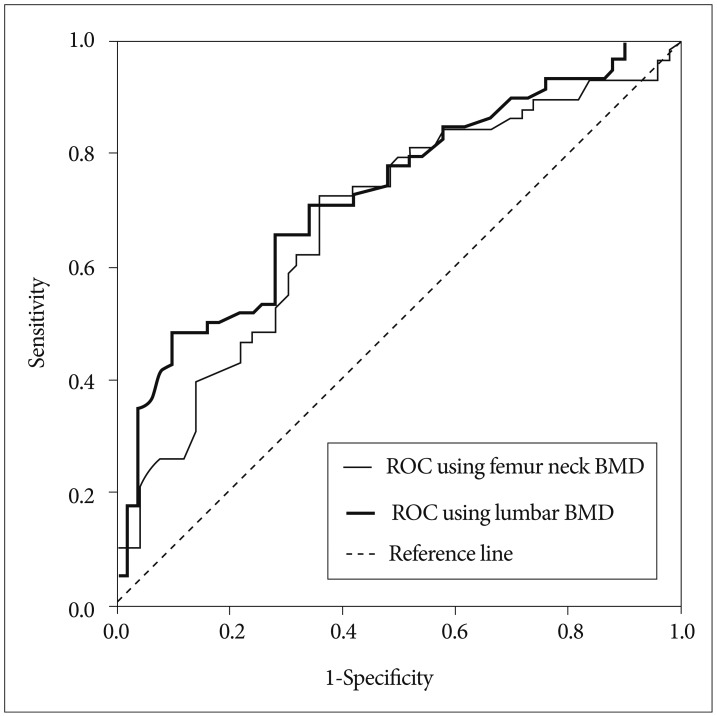J Korean Neurosurg Soc.
2015 Oct;58(4):346-349. 10.3340/jkns.2015.58.4.346.
Usefulness of Fracture Risk Assessment Tool Using Lumbar Bone Mineral Density in Prediction of Osteoporotic Vertebral Fracture
- Affiliations
-
- 1Department of Neurosurgery, Seoul National University Hospital, Seoul, Korea.
- 2Department of Neurosurgery, Seoul National University Boramae Medical Center, Seoul, Korea. ddolbae01@naver.com
- KMID: 2114371
- DOI: http://doi.org/10.3340/jkns.2015.58.4.346
Abstract
OBJECTIVE
To investigate the value of lumbar bone mineral density (BMD) in fracture risk assessment (FRAX) tool.
METHODS
One hundred and ten patients aged over 60 years were enrolled and divided into 2 groups as non-osteoporotic vertebral fracture (OVF) and OVF groups. The 10-year-risk of major osteoporotic vertebral fracture of each group was calculated by FRAX tool with femoral and lumbar spine BMDs to compare the usefulness of lumbar spine BMD in prediction of OVF. The blood level of osteocalcin and C-terminal telopeptide (CTX) as markers of activities of osteoblast and osteoclast, respectively were analyzed using the institutional database.
RESULTS
In the OVF group, the ratio of patients with previous fracture history or use of glucocorticoid was higher than those in non-OVF group (p=0.000 and 0.030, respectively). The levels of T-score of femur neck and lumbar spine in OVF group were significantly lower than those in non-OVF group (p=0.001 and 0.000, respectively). The risk of OVF in FRAX using femur BMD in non-OVF and OVF groups was 6.7+/-6.13 and 11.4+/-10.06, respectively (p=0.007). The risk of using lumbar BMD in the 2 groups was 6.9+/-8.91 and 15.1+/-15.08, respectively (p=0.002). The areas under the receiver operator characteristic curve in the FRAX risk with lumbar and femur neck BMD were 0.726 and 0.684, respectively. The comparison of osteocalcin and CTX was not significant (p=0.162 and 0.369, respectively).
CONCLUSION
In our study, the 10-year risk of major osteoporotic fracture in the OVF group of our study was lower than the recommended threshold of intervention for osteoporosis. Hence, a lower threshold for the treatment of osteoporosis may be set for the Korean population to prevent OVF. In the prediction of symptomatic OVF, FRAX tool using lumbar spine BMD may be more useful than that using femur neck BMD.
Keyword
MeSH Terms
Figure
Reference
-
1. Chin DK, Park JY, Yoon YS, Kuh SU, Jin BH, Kim KS, et al. Prevalence of osteoporosis in patients requiring spine surgery : incidence and significance of osteoporosis in spine disease. Osteoporos Int. 2007; 18:1219–1224. PMID: 17387420.
Article2. Dontas IA, Yiannakopoulos CK. Risk factors and prevention of osteoporosis-related fractures. J Musculoskelet Neuronal Interact. 2007; 7:268–272. PMID: 17947811.3. El Maghraoui A, Roux C. DXA scanning in clinical practice. QJM. 2008; 101:605–617. PMID: 18334497.
Article4. El Maghraoui A, Sadni S, Jbili N, Rezqi A, Mounach A, Ghozlani I. The discriminative ability of FRAX, the WHO algorithm, to identify women with prevalent asymptomatic vertebral fractures : a cross-sectional study. BMC Musculoskelet Disord. 2014; 15:365. PMID: 25366306.5. Fink HA, Milavetz DL, Palermo L, Nevitt MC, Cauley JA, Genant HK, et al. What proportion of incident radiographic vertebral deformities is clinically diagnosed and vice versa? J Bone Miner Res. 2005; 20:1216–1222. PMID: 15940375.
Article6. Fujiwara S, Kasagi F, Masunari N, Naito K, Suzuki G, Fukunaga M. Fracture prediction from bone mineral density in Japanese men and women. J Bone Miner Res. 2003; 18:1547–1553. PMID: 12929946.
Article7. Fujiwara S, Nakamura T, Orimo H, Hosoi T, Gorai I, Oden A, et al. Development and application of a Japanese model of the WHO fracture risk assessment tool (FRAX). Osteoporos Int. 2008; 19:429–435. PMID: 18292977.
Article8. Johnell O, Kanis J. Epidemiology of osteoporotic fractures. Osteoporos Int. 2005; 16(Suppl 2):S3–S7. PMID: 15365697.
Article9. Kanis JA. Diagnosis of osteoporosis and assessment of fracture risk. Lancet. 2002; 359:1929–1936. PMID: 12057569.
Article10. Kanis JA, Borgstrom F, De Laet C, Johansson H, Johnell O, Jonsson B, et al. Assessment of fracture risk. Osteoporos Int. 2005; 16:581–589. PMID: 15616758.
Article11. Kanis JA, Johnell O, Oden A, Johansson H, McCloskey E. FRAX and the assessment of fracture probability in men and women from the UK. Osteoporos Int. 2008; 19:385–397. PMID: 18292978.
Article12. Kanis JA. on behalf of the World Health Organization Scientific Group. Assessment of osteoporosis at the primary health-care level. Technical report University of Sheffield. UK: WHO Collaborating Centre;2008.13. Lewiecki EM. Bone densitometry and vertebral fracture assessment. Curr Osteoporos Rep. 2010; 8:123–130. PMID: 20556673.
Article14. Lippuner K, Johansson H, Kanis JA, Rizzoli R. FRAX assessment of osteoporotic fracture probability in Switzerland. Osteoporos Int. 2010; 21:381–389. PMID: 19517155.
Article15. McCloskey E, Kanis JA. FRAX updates 2012. Curr Opin Rheumatol. 2012; 24:554–560. PMID: 22820516.
Article16. Navarro MC, Sosa M, Saavedra P, Lainez P, Marrero M, Torres M, et al. Poverty is a risk factor for osteoporotic fractures. Osteoporos Int. 2009; 20:393–398. PMID: 18773136.
Article17. Siris ES, Baim S, Nattiv A. Primary care use of FRAX : absolute fracture risk assessment in postmenopausal women and older men. Postgrad Med. 2010; 122:82–90. PMID: 20107292.
Article18. Siris ES, Brenneman SK, Barrett-Connor E, Miller PD, Sajjan S, Berger ML, et al. The effect of age and bone mineral density on the absolute, excess, and relative risk of fracture in postmenopausal women aged 50-99 : results from the National Osteoporosis Risk Assessment (NORA). Osteoporos Int. 2006; 17:565–574. PMID: 16392027.
Article
- Full Text Links
- Actions
-
Cited
- CITED
-
- Close
- Share
- Similar articles
-
- Feasibility of FRAX for Prediction of Osteoporotic Vertebral Fractures in Korea
- Correlation of the Bone Mineral Density with Morphometric Dimensions and Characteristics of Osteoporotic Vertebral Fracture
- Differences of Bone Mineral Density between Spine and Hip in Osteoporotic Patients
- Occurrence of vertebral fracture more closely associated with decreased anteroposterior than lateral lumbar bone mineral density
- Potential Biomarkers to Improve the Prediction of Osteoporotic Fractures


